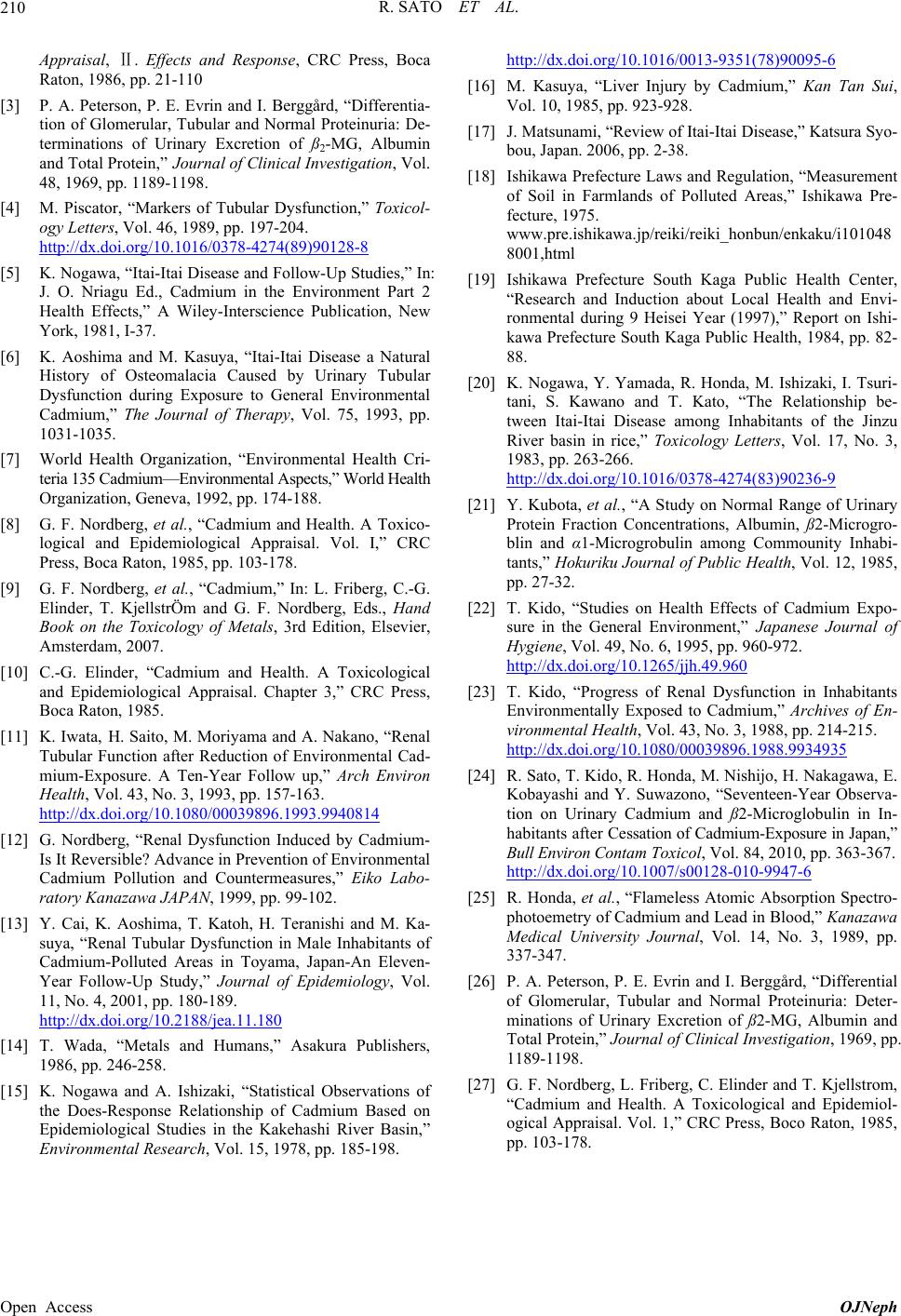
R. SATO ET AL.
210
Appraisal, .Ⅱ Effects and Response, CRC Press, Boca
Raton, 1986, pp. 21-110
[3] P. A. Peterson, P. E. Evrin and I. Berggård, “Differentia-
tion of Glomerular, Tubular and Normal Proteinuria: De-
terminations of Urinary Excretion of ß2-MG, Albumin
and Total Protein,” Journal of Clinical Investigation, Vol.
48, 1969, pp. 1189-1198.
[4] M. Piscator, “Markers of Tubular Dysfunction,” Toxicol-
ogy Letters, Vol. 46, 1989, pp. 197-204.
http://dx.doi.org/10.1016/0378-4274(89)90128-8
[5] K. Nogawa, “Itai-Itai Disease and Follow-Up Studies,” In:
J. O. Nriagu Ed., Cadmium in the Environment Part 2
Health Effects,” A Wiley-Interscience Publication, New
York, 1981, I-37.
[6] K. Aoshima and M. Kasuya, “Itai-Itai Disease a Natural
History of Osteomalacia Caused by Urinary Tubular
Dysfunction during Exposure to General Environmental
Cadmium,” The Journal of Therapy, Vol. 75, 1993, pp.
1031-1035.
[7] World Health Organization, “Environmental Health Cri-
teria 135 Cadmium—Environmental Aspects,” World Health
Organization, Geneva, 1992, pp. 174-188.
[8] G. F. Nordberg, et al., “Cadmium and Health. A Toxico-
logical and Epidemiological Appraisal. Vol. I,” CRC
Press, Boca Raton, 1985, pp. 103-178.
[9] G. F. Nordberg, et al., “Cadmium,” In: L. Friberg, C.-G.
Elinder, T. KjellstrÖm and G. F. Nordberg, Eds., Hand
Book on the Toxicology of Metals, 3rd Edition, Elsevier,
Amsterdam, 2007.
[10] C.-G. Elinder, “Cadmium and Health. A Toxicological
and Epidemiological Appraisal. Chapter 3,” CRC Press,
Boca Raton, 1985.
[11] K. Iwata, H. Saito, M. Moriyama and A. Nakano, “Renal
Tubular Function after Reduction of Environmental Cad-
mium-Exposure. A Ten-Year Follow up,” Arch Environ
Health, Vol. 43, No. 3, 1993, pp. 157-163.
http://dx.doi.org/10.1080/00039896.1993.9940814
[12] G. Nordberg, “Renal Dysfunction Induced by Cadmium-
Is It Reversible? Advance in Prevention of Environmental
Cadmium Pollution and Countermeasures,” Eiko Labo-
ratory Kanazawa JAPAN, 1999, pp. 99-102.
[13] Y. Cai, K. Aoshima, T. Katoh, H. Teranishi and M. Ka-
suya, “Renal Tubular Dysfunction in Male Inhabitants of
Cadmium-Polluted Areas in Toyama, Japan-An Eleven-
Year Follow-Up Study,” Journal of Epidemiology, Vol.
11, No. 4, 2001, pp. 180-189.
http://dx.doi.org/10.2188/jea.11.180
[14] T. Wada, “Metals and Humans,” Asakura Publishers,
1986, pp. 246-258.
[15] K. Nogawa and A. Ishizaki, “Statistical Observations of
the Does-Response Relationship of Cadmium Based on
Epidemiological Studies in the Kakehashi River Basin,”
Environmental Research, Vol. 15, 1978, pp. 185-198.
http://dx.doi.org/10.1016/0013-9351(78)90095-6
[16] M. Kasuya, “Liver Injury by Cadmium,” Kan Tan Sui,
Vol. 10, 1985, pp. 923-928.
[17] J. Matsunami, “Review of Itai-Itai Disease,” Katsura Syo-
bou, Japan. 2006, pp. 2-38.
[18] Ishikawa Prefecture Laws and Regulation, “Measurement
of Soil in Farmlands of Polluted Areas,” Ishikawa Pre-
fecture, 1975.
www.pre.ishikawa.jp/reiki/reiki_honbun/enkaku/i101048
8001,html
[19] Ishikawa Prefecture South Kaga Public Health Center,
“Research and Induction about Local Health and Envi-
ronmental during 9 Heisei Year (1997),” Report on Ishi-
kawa Prefecture South Kaga Public Health, 1984, pp. 82-
88.
[20] K. Nogawa, Y. Yamada, R. Honda, M. Ishizaki, I. Tsuri-
tani, S. Kawano and T. Kato, “The Relationship be-
tween Itai-Itai Disease among Inhabitants of the Jinzu
River basin in rice,” Toxicology Letters, Vol. 17, No. 3,
1983, pp. 263-266.
http://dx.doi.org/10.1016/0378-4274(83)90236-9
[21] Y. Kubota, et al., “A Study on Normal Range of Urinary
Protein Fraction Concentrations, Albumin, ß2-Microgro-
blin and α1-Microgrobulin among Commounity Inhabi-
tants,” Hokuriku Journal of Public Health, Vol. 12, 1985,
pp. 27-32.
[22] T. Kido, “Studies on Health Effects of Cadmium Expo-
sure in the General Environment,” Japanese Journal of
Hygiene, Vol. 49, No. 6, 1995, pp. 960-972.
http://dx.doi.org/10.1265/jjh.49.960
[23] T. Kido, “Progress of Renal Dysfunction in Inhabitants
Environmentally Exposed to Cadmium,” Archives of En-
vironmental Health, Vol. 43, No. 3, 1988, pp. 214-215.
http://dx.doi.org/10.1080/00039896.1988.9934935
[24] R. Sato, T. Kido, R. Honda, M. Nishijo, H. Nakagawa, E.
Kobayashi and Y. Suwazono, “Seventeen-Year Observa-
tion on Urinary Cadmium and ß2-Microglobulin in In-
habitants after Cessation of Cadmium-Exposure in Japan,”
Bull Environ Contam Toxicol, Vol. 84, 2010, pp. 363-367.
http://dx.doi.org/10.1007/s00128-010-9947-6
[25] R. Honda, et al., “Flameless Atomic Absorption Spectro-
photoemetry of Cadmium and Lead in Blood,” Kanazawa
Medical University Journal, Vol. 14, No. 3, 1989, pp.
337-347.
[26] P. A. Peterson, P. E. Evrin and I. Berggård, “Differential
of Glomerular, Tubular and Normal Proteinuria: Deter-
minations of Urinary Excretion of ß2-MG, Albumin and
Total Protein,” Journal of Clinical Investigation, 1969, pp.
1189-1198.
[27] G. F. Nordberg, L. Friberg, C. Elinder and T. Kjellstrom,
“Cadmium and Health. A Toxicological and Epidemiol-
ogical Appraisal. Vol. 1,” CRC Press, Boco Raton, 1985,
pp. 103-178.
Open Access OJNeph